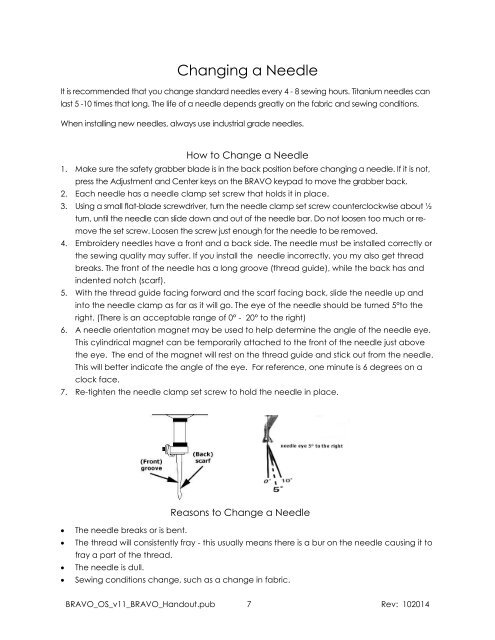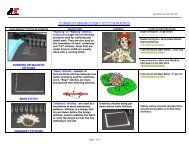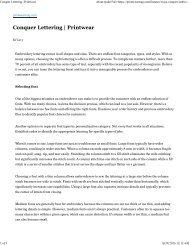Melco Compilation
You also want an ePaper? Increase the reach of your titles
YUMPU automatically turns print PDFs into web optimized ePapers that Google loves.
Changing a Needle<br />
When installing new needles, always use industrial grade needles.<br />
How to Change a Needle<br />
1. Make sure the safety grabber blade is in the back position before changing a needle. If it is not,<br />
press the Adjustment and Center keys on the BRAVO keypad to move the grabber back.<br />
2. Each needle has a needle clamp set screw that holds it in place.<br />
3. Using a small flat-blade screwdriver, turn the needle clamp set screw counterclockwise about ½<br />
turn, until the needle can slide down and out of the needle bar. Do not loosen too much or remove<br />
the set screw. Loosen the screw just enough for the needle to be removed.<br />
4. Embroidery needles have a front and a back side. The needle must be installed correctly or<br />
the sewing quality may suffer. If you install the needle incorrectly, you my also get thread<br />
breaks. The front of the needle has a long groove (thread guide), while the back has and<br />
indented notch (scarf).<br />
5. With the thread guide facing forward and the scarf facing back, slide the needle up and<br />
into the needle clamp as far as it will go. The eye of the needle should be turned 5°to the<br />
right. (There is an acceptable range of 0° - 20° to the right)<br />
6. A needle orientation magnet may be used to help determine the angle of the needle eye.<br />
This cylindrical magnet can be temporarily attached to the front of the needle just above<br />
the eye. The end of the magnet will rest on the thread guide and stick out from the needle.<br />
This will better indicate the angle of the eye. For reference, one minute is 6 degrees on a<br />
clock face.<br />
7. Re-tighten the needle clamp set screw to hold the needle in place.<br />
Reasons to Change a Needle<br />
<br />
<br />
<br />
<br />
The needle breaks or is bent.<br />
The thread will consistently fray - this usually means there is a bur on the needle causing it to<br />
fray a part of the thread.<br />
The needle is dull.<br />
Sewing conditions change, such as a change in fabric.<br />
BRAVO_OS_v11_BRAVO_Handout.pub 7 Rev: 102014




